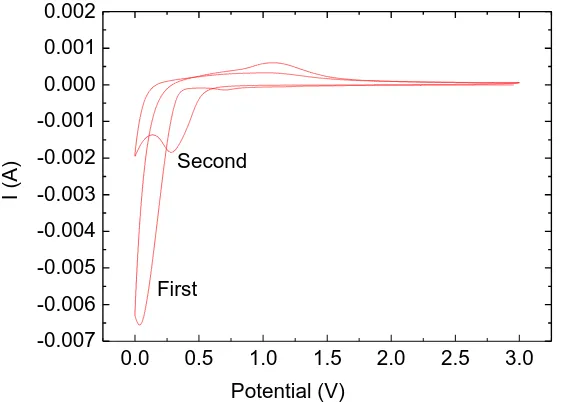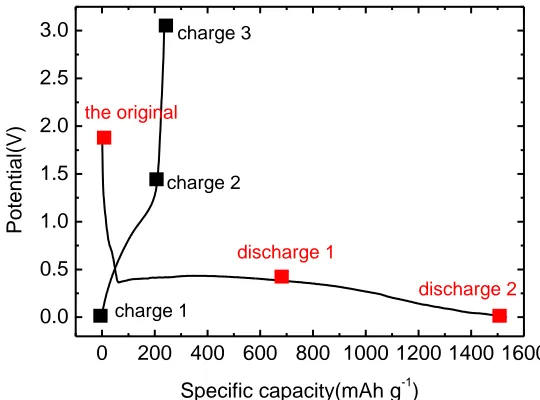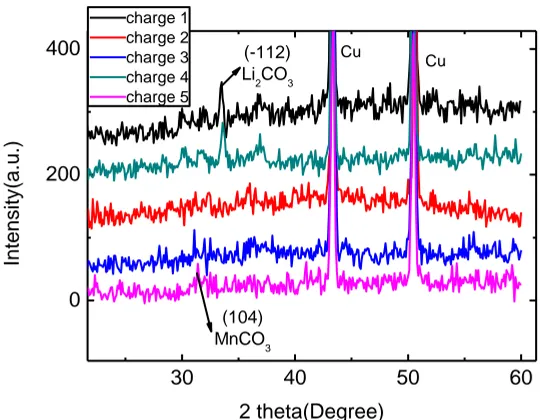Int. J. Electrochem. Sci., 8 (2013) 1170 - 1180
International Journal of
ELECTROCHEMICAL
SCIENCE
www.electrochemsci.org
Electrochemical Characteristics and Intercalation Mechanism of
Manganese Carbonate as Anode Material for Lithium-Ion
Batteries
Lianyi Shao, Jie Shu*, Rui Ma, Miao Shui, Lu Hou, Kaiqiang Wu, Dongjie Wang, Yuanlong Ren
Faculty of Materials Science and Chemical Engineering, Ningbo University, Ningbo 315211, Zhejiang Province, People’s Republic of China
*
E-mail: sergio_shu@hotmail.com; shujie@nbu.edu.cn
Received: 21 November 2012 / Accepted: 11 December 2012 / Published: 1 January 2013
In this paper, manganese carbonate is used as a lithium storage material for lithium-ion batteries. The electrochemical properties of manganese carbonate are studied by cyclic voltammetry and galvanostatic charge-discharge technique. The electrochemical results show that manganese carbonate has a high initial capacity of 1534.6 mAh·g-1
. By using ex-situ infrared method and ex-situ X-ray diffraction technique, the electrochemical reaction mechanism of manganese carbonate with lithium is a reversible conversion between Mn2+ and Mn0. The electrochemical reaction between lithium and manganese carbonate can lead to the formation of manganese metal and lithium carbonate. In the reverse charge process, manganese metal and lithium carbonate can return back to lithium and manganese carbonate. Therefore, it is expected that manganese carbonate can be a promising anode material for lithium-ion batteries.
Keywords: Lithium-ion batteries; Anode material; Manganese carbonate; Ex-situ infrared spectroscopy; Ex-situ X-ray diffraction technique
1. INTRODUCTION
of the most important part attributed to its low cost and high capacity characteristics. Thus, it is necessary to explore novel promising anode materials for lithium-ion batteries.
Manganese oxide, such as MnO or MnO2, is a kind of attractive electrode materials because of the advantages of high conductivity, high theoretical capacity (>300 mAh·g-1), high energy density, low cost, low toxicity and abundant resources [1-5]. Contributed to these advantages, Mn-based active materials have been widely used in lithium primary cell. Nowadays, manganese oxide gradually becomes the active materials of the cathode in secondary lithium-ion batteries. However, it has many serious problems in practical commercial application field, such as poor cycle calendar life and low reversible capacity. For comparison, manganese carbonate is another new active material for lithium-ion batteries due to its high theoretical capacity based on a converslithium-ion topotaxial reactlithium-ion. Therefore, it may be a promising anode material for rechargeable lithium-ion batteries.
In this work, we not only observe the physical properties of manganese carbonate by using Fourier transform infrared (FTIR) spectroscopy and X-ray diffraction (XRD) method, but also study the electrochemical properties of manganese carbonate through cyclic voltammetry and galvanostatic charge-discharge technique. In addition, we use the ex-situ infrared and ex-situ X-ray diffraction techniques to get a better understanding on the working mechanism of manganese carbonate as anode material for lithium-ion batteries.
2. EXPERIMENTAL SECTION
2.1 Structural and morphological characterization
Commercial MnCO3 used in the experiment was purchased from Sinopharm Chemical Reagent Shanghai Co. Ltd in China. FTIR spectra were obtained by a Shimadzu FTIR-8900 spectrometer with the wavenumber range from 400 to 4000 cm-1. The lithiated and delitiated samples for ex-situ FTIR study are washed by dimethyl carbonate and vacuummed for 2 h before mixing with KBr. XRD patterns were carried out using a Bruker AXS D8 Focus diffractometer with Cu Kα radiation (λ= 0.15406 nm), operating at 40 kV and 40 mA. A scan angle range between 10 and 80°, a step size of 0.1°, and a count time of 1 s were used in the experiment. The scanning electron microscopy (SEM) images were obtained with a JEOL S3400 instrument working at 10.0 kV. Thermogravimetric (TG) and differential thermal analysis (DTA) curves were obtained by a Seiko TG/DTA 6300 instrument under argon atmosphere.
2.2 Electrochemical characterization
using manganese carbonate as cathode, lithium metal as anode, Whatman glass fiber as separator and 1 mol·dm-3
solution of LiPF6 as electrolyte. The LiPF6 solution was composed of ethylene carbonate (EC) and dimethyl carbonate (DMC) with a volume proportion of 1:1.
Galvanostatic charge-discharge cycles for simulated batteries were gained by multi-channel Land battery test system (Wuhan Jinnuo, China). All the simulated batteries were charged and discharged in 0.0-3.0 V at room temperature by using a constant current density of 50 mAh·g-1. Besides, cyclic voltammograms were obtained by a CHI 1000B electrochemical workstation (Shanghai Chenhua, China).
3. RESULTS AND DISCUSSION
10 20 30 40 50 60 70 80
0 200 400 600 800 1000 1200
(12
8)
(12
5)
(10
10
)
(12
2)
(02
4)
(11
6)
(20
2)
(11
3)
(11
0)
(10
4)
(01
2)
Intensity(a.u
.)
[image:3.596.160.431.276.477.2]2 theta(Degree)
Figure 1. XRD pattern of commercial manganese carbonate.
0 100 200 300 400 500 600 700 800 900
60 80 100
TG DTA
Temp (Cel)
TG (%)
-14 -12 -10 -8 -6 -4 -2 0
DTA (uV)
[image:3.596.160.447.535.741.2]
The XRD pattern of manganese carbonate is shown in Fig.1. It is a typical calcite-type Rhombohedral structure compound with the three strongest reflections at (104), (012) and (116) lines. This pattern is in good agreement with the JCPDS card No. 86-0173 and the previous reports [5,6]. The cell parameters of Rhombohedral manganese carbonate is a= 4.778 Å, c=15.642 Å, and its space group is c(167).
The TG-DTA curves for manganese carbonate are recorded in Fig.2. As shown in this Figure, the thermal decomposition process of manganese carbonate has only one step [7,8]:
MnCO3→ MnO + CO2 (1)
On the basis of the DTA curve, the thermal decomposition reaction is an endothermic reaction. The calcite-type Rhombohedral structure of manganese carbonate starts to decompose at around 370 0
[image:4.596.92.503.318.470.2]C. Reaction (1) finishes at about 430 0C with a total weight loss of 49.81 %.
Figure 3. SEM micrographs of manganese carbonate.
0.0 0.5 1.0 1.5 2.0 2.5 3.0
-0.007 -0.006 -0.005 -0.004 -0.003 -0.002 -0.001 0.000 0.001 0.002
I (A)
Potential (V) First
Second
[image:4.596.141.423.537.738.2]
The surface morphology of manganese carbonate is shown in Fig.3. Without sample pretreatment, the surface of manganese carbonate particles is spherical shape but not smooth. It is obvious that manganese carbonate particles with an average size of about 1 μm agglomerating together to form a secondary particle. These secondary particles have an average particle size between 10 and 20 μm.
Fig.4 illustrates the initial two cyclic voltammograms of manganese carbonate at a scan rate of 1×10−4 V·s-1. This profile is similar with the electrochemical behaviors of MnO as reported by Wang [9]. However, no cyclic voltammogram of manganese carbonate has ever been reported as anode material for lithium-ion batteries in the past ten years [5,7,8,10]. As shown in Fig.4, the first reduction scanning process appears a broad peak at 0.04 V. A sharp peak at 0.01 V and a broad peak at 0.29 V are shown in the second reduction scanning process. The decrease of reduction peak current and the shift of peak potential indicate the presence of a partial irreversible phase transition during the electrochemical reaction between manganese carbonate and lithium in the first and second cycles. Furthermore, it is also found that these two cyclic voltammograms both have a single broad anodic peak at around 1.10 V. The potential polarization between insertion and extraction process is about 1.0 V as shown in the cyclic voltammograms. It suggests that the extraction of lithium is difficult for lithiated manganese carbonate.
0 200 400 600 800 1000 1200 1400 1600
0.0 0.5 1.0 1.5 2.0 2.5 3.0
0 10 20 30 40 50 0 200 400 600 800 1000 1200 1400 1600 S p e c if ic c a p a c it y (m A h g -1) Cycle number discharge charge 0-3V Potential(V)
Specific capacity(mAh g-1)
1 1
[image:5.596.156.426.382.587.2]2 2
Figure 5. Charge-discharge curves of manganese carbonate at the current density of 50 mA·g-1.
The electrochemical properties are further investigated by charge-discharge testing with the simulated batteries cycling at a current density of 50 mA·g-1
charge curve is similar with the second one. Both charge curves possess a slope potential plateau at about 1.2 V, undergoing an oxidation reaction of Mn0 to Mn2+. For each conversion electrode material, the first step can be described by using the following equation:
MnCO3 + 2Li ↔ Li2CO3 + Mn (2)
The relation between the cycle number and specific capacity is also studied. Viewed from the cycling results, it is found that the initial discharge specific capacity for manganese carbonate is 1534.6 mAh·g-1
. In the subsequent cycles, the specific capacity decreases from 244.3 to 27.8 mAh·g-1. The charge capacity from the 2nd to 51th cycle reduces from 154.5 to 26.2 mAh·g-1. Theoretically, the initial irreversible capacity of conversion electrodes is always much larger than that of the following cycles [5]. The initial irreversible capacity for active material is 1299.2 mAh·g-1
. Based on the previous reports, it is known that the initial irreversible capacity of manganese carbonate can be associated with particle pulverization, electrolyte degradation, the formation of a solid electrolyte interphase and the insertion reaction in carbon black additive [5,10]. As a result, the reversible capacity can not reach the theoretical value (466 mA·g-1
) of manganese carbonate [10]. As shown in Fig.3, manganese carbonate particles aggregate together leading to a low surface area, which can not provide much more material/electrolyte interface for lithium ion diffusion. Moreover, the active particles pulverize and become electrochemically inactive materials upon repeated cycles. Therefore, only low specific capacity can be delivered after many cycles [11].
0 200 400 600 800 1000 1200 1400 1600
0.0 0.5 1.0 1.5 2.0 2.5 3.0
.
Potential(V)
Specific capacity(mAh g-1)
the original
discharge 1
discharge 2
.
.
charge 1 charge 2
charge 3
.
[image:6.596.155.425.434.634.2].
.
Figure 6. Six lithiated and delithiated samples obtained for ex-situ FTIR analysis in the initial charge-discharge curve.
in metal carbonates, we make a thoroughly investigation on the structural evolutions of manganese carbonate during charge-discharge cycles by using ex-situ FTIR and ex-situ XRD techniques.
Here, we assembled six simulated batteries in the ex-situ FTIR experiment, named the original, discharge 1, discharge 2, charge 1, charge 2 and charge 3. We prepared three lithiated samples with the names of the original, discharge 1 and discharge 2 as shown in Fig.6. In the reverse charge process, three delithiated samples are named as charge 1, charge 2 and charge 3. After charge or discharge, the forenamed slices were rinsed with DMC in an argon-filled glove box, dried under vacuum conditions at room temperature and then analyzed by FTIR technique.
500 1000 1500 2000 2500 3000 3500
40 50 60 70 80 90 100
T(%)
Wave number(cm-1)
the original discharge 1 discharge 2
859
1412
[image:7.596.161.419.227.428.2]3472 1643
Figure 7. Ex-situ FTIR spectra of the original manganese carbonate and other two lithiated samples in the initial discharge curve.
500 1000 1500 2000 2500 3000 3500
80 82 84 86 88 90 92 94 96 98 100
T(%)
Wave number(cm-1)
charge1 charge2 charge3
3446 1635
[image:7.596.158.418.486.687.2]1427 864
Figure 8. Ex-situ FTIR spectra of three delithiated samples in the initial charge curve.
stretching vibrations of water molecules, respectively. The characteristic peaks at 1412 and 859 cm-1 are contributed to CO32- vibrations [6,12]. With the discharge process proceeding, the intensities of characteristic peaks for CO32- decrease gradually. It indicates that there is a transformation reaction of Mn2+ to Mn0 during lithium insertion process. Viewed from Fig.8, the delithiated active materials have similar infrared feactured peaks of CO32- in the charge process. Contrary to the discharge process, the intensities of characteristic peaks for CO32- show a gradual strengthening in charge process due to a reverse transformation process of Mn0 to Mn2+. Based on the ex-situ FTIR results, it is obvious that the reaction mechanism of MnCO3 with Li is consistent with the equation 2 mentioned above
0 200 400 600 800 1000 1200 1400 1600
0.0 0.5 1.0 1.5 2.0 2.5 3.0
.
Potential(V)Specific capacity(mAh g-1)
[image:8.596.156.427.231.423.2]the original
.
discharge 2 discharge 4.
•
.
.
charge 1 charge 5.
discharge 1 discharge 3.
.
charge 2 charge 3 charge 4.
.
Figure 9. Ten lithiated and delithiated samples obtained for ex-situ XRD analysis in the initial charge-discharge curve.
20 30 40 50 60
0 500 1000 1500 2000 2500 Intensity(a.u. ) 2 theta(Degree) the original discharge 1 discharge 2 discharge 3 discharge 4 (01 2) (10 4) (1 1 0 )
(-112),Li2CO3
Cu Cu (1 1 6 ) (1 1 3 ) (2 0 2 )
[image:8.596.144.424.485.686.2]
Based on the ex-situ infrared results, we make a preliminary understanding on the working mechanism of manganese carbonate in the process of charge-discharge cycles. In order to better understand the conversion reaction, we make ex-situ XRD study on the structural evolutions of active materials as anode for lithium-ion batteries. Here, we assembled 12 simulated batteries in the ex-situ XRD experiment, named the original, discharge 1, discharge 2, discharge 3, discharge 4, discharge 5, charge 1, charge 2, charge 3, charge 4, charge 5 and charge 6. We prepared five lithiated samples with the names of with the names of the original, discharge 1, discharge 2, discharge 3 and discharge 4 as shown in Fig.9. In the reverse charge process, five delithiated samples named charge 1, charge 2, charge 3, charge 4 and charge 5 are prepared as shown in Fig.9. After charge or discharge, the forenamed slices were obtained from the simulated batteries in an argon-filled glove box, dried under vacuum conditions and then studied by XRD. The ex-situ XRD patterns of five lithiated samples in discharge process are depicted in Fig.10. It is obvious that six bragg reflections attributed to (012), (104), (110), (113), (202) and (116) lines belong to the characteristic peaks of manganese carbonate. In the discharge process, the intensities of these six diffraction peaks become weaker and weaker from the original one to the discharge 4. Furthermore, a new bragg reflection can be observed in the ex-situ XRD pattern of the discharge 4 sample. According to the JCPDS card No.83-1454, we realize that this new peak belongs to the characteristic diffraction peak of lithium carbonate (Li2CO3), corresponding to the crystal face (-112). It indicates that the initial electrochemical transformation of Mn2+ to Mn0 results in the formation of Li2CO3.
30 40 50 60
0 200 400
Intensity(a.u
.)
2 theta(Degree) charge 1
charge 2 charge 3 charge 4 charge 5
Cu
Cu
(104)
MnCO3
(-112) Li
[image:9.596.149.419.422.632.2]2CO3
Figure 11. Ex-situ FTIR spectra of five delithiated samples in the initial charge curve.
the diffraction peak at 33.4° attributed to Li2CO3 become weaker and weaker from the charge 1 to the charge 5. Moreover, a weak bragg reflection reappears in the XRD curve of the charge 4 and 5, which is corresponding to the characteristic (104) reflection line of manganese carbonate (JCPDS card No. 86-0173). These results suggest that the reverse transformation of Mn0 to Mn2+ is feasible during the charge process. Therefore, the electrochemical reaction between manganese carbonate and lithium is reversible process shifting from manganese metal and lithium carbonate.
4. CONCLUSIONS
In our experiment, cyclic voltammogram and galvanostatic charge-discharge cycle of manganese carbonate demonstrate that metal carbonates (MCO3, M=Mn, Fe, Co, Ni, Cu) are promising lithium storage materials as anode materials for lithium-ion batteries. The structural evolutions of manganese carbonate were observed by ex-situ XRD and ex-situ FTIR techniques during the initial charge-discharge cycle. The shift of characteristic diffraction peaks and infrared absorption peaks indicate the reversible structural conversion between Mn2+ and Mn0. These results prove that the reaction of manganese carbonate with lithium can lead to the formation of manganese metal and lithium carbonate. It also shows that manganese metal and lithium carbonate can reversibly change into lithium and manganese carbonate during the charge process. In addition, the initial discharge specific capacity of manganese carbonate reaches a value of 1534.6 mAh·g-1. Based on these results, it is obvious that manganese carbonate will be a promising lithium storage material for lithium-ion batteries.
ACKNOWLEDGEMENT
This project is sponsored by National Science Foundation of China (No. 51104092), Key Project of Chinese Ministry of Education (No. 210083) and Qianjiang Talent Project of Zhejiang Province (2011R10089). The work is also supported by K. C. Wong Magna Fund in Ningbo University.
References
1. R. N. Reddy, R. G. Reddy, J. Power Sources, 132 (2004) 315.
2. S. J. Bao, B. L. He, Y. Y. Liang, W. J. Zhou, H. L. Li, Mater. Sci. Eng. A, 397 (2005) 305. 3. J. Li, N. Wang, Y. Zhao, Y. Ding, L. Guan, Electrochem. Commun., 13 (2011) 698.
4. M. Malisic, A. Janosevic, B. S. Paunkovica, I. Stojkovic, G. Ciric-Marjanovic, Electrochim. Acta, 74 (2012) 158.
5. M. J. Aragon, B. Leon, C. P. Vicente, J. L. Tirado, J. Power Sources, 196 (2011) 2863. 6. S. M. Pourmortazavi, M. Rahimi-Nasrabadi, A. A. Davoudi-Dehaghani, A. Javidan, M. M.
Zahedi, S. Hajimirsadeghi, Mater. Res. Bull., 47 (2012) 1045.
7. S. Mirhashemihaghighi, B. Leon, C. P. Vicente, J. L. Tirado, R. Stoyanova, M. Yoncheva, E. Zhecheva, R. S. Puche, E. M. Arroyo, J. R. Paz, Inorg. Chem., 51 (2012) 5554.
11. C. H. Lu, S. W. Lin, J. Power Sources, 97-98 (2001) 458.
12. L. X. Yang, Y. Liang, H. Chen, Y. F. Meng, W. Jiang, Mater. Res. Bull., 44 (2009) 1753.






